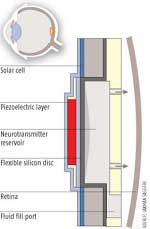 |
Schematic of the implantable device. (Image: NewScientist) |
American scientists are proposing a solution to implant a solar-powered chip into the eyes of blind individuals. This chip will activate retinal cells by delivering neurotransmitters that could restore vision.
Unlike traditional implant techniques that use direct electrical currents to stimulate retinal cells, the new device does not heat the cells. It also consumes very little energy, eliminating the need for additional batteries.
The retina (the layer connecting the back and side of the eyeball) contains photoreceptor cells responsible for releasing signaling chemicals—known as neurotransmitters—in response to light. These chemicals enter the nerve cells located at the top of the photoreceptive area, where signals are relayed to the brain through a series of chemical and electrical reactions. In individuals with retinal diseases, such as age-related macular degeneration and retinitis, the photoreceptors are damaged and cannot release neurotransmitters, gradually leading to blindness.
Last year, engineer Laxman Saggere from the University of Illinois at Chicago introduced an implant technique to replace these photoreceptors with a pump system that responds to light for neurotransmitter release. He has now developed the main component of the device: a solar-powered piezoelectric motor that responds to very low light intensities reaching the retina. Multiple such motors attached to a single chip will gather detailed information about images focused on the retina, allowing some “pixels” to be transmitted to the brain.
The principle works as follows: When light hits the solar cell on the implant chip, it generates a voltage. This voltage activates the piezoelectric motor, producing a pulse of neurotransmitters that is sent to the retina.
T. An



















































